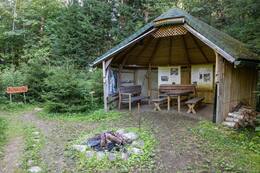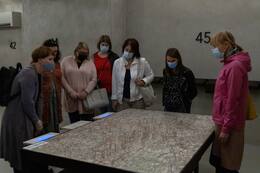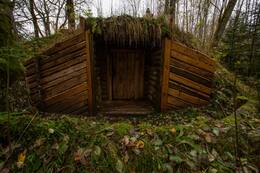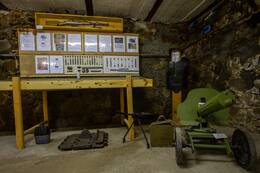Miško brolių pėdomis Latvijoje ir Estijoje
Diena 3.
195 km
Rīga–Amata–Cēsis–Skujene–Vecpiebalga–Ineši–Madona
Praktinė informacija
- Driving distance: 195 km
- Visits to the national partisans’ bunkers in Amata and Sērmūkši, and the Piebalga exhibition should be booked in advance.
- Opening times for the Multimedia Exposition “Burning Conscience” sirdsapzinasugunskurs.lv
- Guided visits to the Piebalga exposition should be booked in advance +371 22407218 (in Latvian).
Lankytinos vietos
Bunker of national partisans – Forest Brothers
The Forest Brothers’ Bunker is located by the Riga-Pskov (A2) highway 76 kilometres from Riga and 11 kilometres from Cēsis. The Latvian national partisans or Forest Brothers were small, armed groups of local residents who fought their independent battles against the occupation regime of the USSR in the territory of Latvia from 1944 to 1956. Forced to hide in the forests, these were people who could not or did not want to live in the Soviet Union. A total of around 20,193 Forest Brothers operated in Latvia. The bunker was formed based on the stories and memories of former Forest Brothers about life in the forests, hiding and fighting for the independent state of Latvia after 1945. The bunker showcases armaments and household items. The personal belongings, weapons and photos of partisans are on display. The guide’s narration is enriched by a video from interviews with Forest Brothers. There is a place for picnic campfires by the bunker. It is possible to pre-order a soup prepared on the fire or enjoy an evening of outdoor cinema by the fire.
Historical Exposition “The Burning Conscience”
The historical exhibit ‘Fire of Conscience’ is located in Cēsis, near the Cēsis Castle Square. Established in a Soviet-era temporary detention facility, it tells about the occupation of Latvia and reveals surprising and heroic stories of resistance from individuals. The yard features a memorial wall with the names of 643 residents of the former Cēsis district who died in Soviet repressions, including national partisans deported in 1941 and 1949 and those shot and sentenced to death. The exhibit’s timeline encourages visitors to study the course of the occupation of Latvia from 1939 to 1957. Arranged by topics, quotes from local newspapers offer a comparison of the political propaganda of the two occupation regimes. The six cells for temporary detention have survived to the present day in their original form from 1940 to 1941 and the post-war years. Here, the residents of Cēsis district, detained for various anti-Soviet activities, including national partisans, their supporters, young people who distributed anti-Soviet leaflets and other ‘traitors of the motherland’, were held for several days during the initial investigation and interrogation before being sent to the main KGB Building in Riga. Everything here is real: cells with iron doors, built-in ‘kormushkas’ (small openings for providing food), plank beds, a latrine for detainees, a small kitchen with an oven, as well as typical Soviet-era oil paint on the walls. In 2019, the exhibit was ranked third in the national design competition, the Latvian Design of the Year Award.
Memorial site of national partisans in Sērmūkši
Sērmūkši is home to one of more than a hundred memorials to partisan battles in Latvia. There are more than six hundred partisan battle sites in Latvia. A Latvian national partisan dugout has been built based on historical evidence, and visitors can spend the night in near-authentic conditions with plank beds, lighting provided by kerosene lamps and a heating device similar to the ones used by partisans. Visits must be booked in advance. The fateful moment for the Sērmūkši National Partisan Group came on 29 November 1946 with the deaths of four fighters from the group: Jānis Zīrāks, Reinholds Pētersons, Jānis Pīlands and Anna Zariņa. Alfrēds Suipe survived, endured deportation, returned to Latvia and saw the restoration of a free state. He initiated the idea to establish a memorial site for his fallen companions in Sērmūkši.
Piebalga local history exposition in Ineši
The local history exhibit is located in the wine cellar building of the Vecpiebalga Manor in Ineši. It covers a wide range of World War II events in the area. The exhibit located in the basement features ammunition, weapons, soldiers’ household items, aircraft debris, badges and awards, battle maps and other items related to the war. The front line is marked on a unique map displayed on the ground floor. The map is well preserved despite being located in the swamp for many years. Interesting historical evidence of Voldemārs Ozols (1884–1949), an officer of six armies, is displayed on the first floor. The exhibit on Voldemārs Ozols is significantly enriched by the story told by Mārtiņš Frīdvalds who translated Manfrēds Šneps-Šneppe’s book ‘Pasaules „šaha spēles” un Voldemārs Ozols sešu armiju virsnieks’ (Chess Games of the World and Voldemārs Ozols, an Officer of Six Armies) from Russian. The book is a popular study on General Voldemārs Ozols, a controversial but outstanding Latvian military figure. The story about him covers World War I, the Latvian War of Independence and World War II. Mārtiņš Frīdvalds also talks about the political, economic and cultural history of Piebalga and the manor. The duration of the tour is 1 to 1.5 hours. Also included in the exhibit are farmers’ tools and household items, accounts from witnesses to historical events and the history of the Ineši Theatre. The exhibition is regularly supplemented with newly acquired items and new discoveries related to the history of Piebalga municipality made in recent years.
The Vecpiebalga Estate
The estate is in the centre of Ineši, 5 km to the south of Vecpiebalga. The estate dates back to the latter half of the 17th century, when an ornate castle for the noble Sheremetyev family was built here in the style of Classicism and on the banks of the little Orisāre River. The castle was built down during the 1905 Revolution, but restored four years later. Around the castle is a lovely landscape park. The castle served as the prototype for the Slātava Estate in the famous novel “Age of the Surveyors” by the Kaudzīte brothers. In 1992, the Piebalga Administrative District Museum was opened in the wine cellar of the castle, which is home to the Ineši Parish Council and a porcelain painting studio. Organised tours of the estate and its surrounding area are available.
Vietos pavalgyti
Tavern PIE DZIRNAKMEŅA
The tavern and pastry shop is located near the Vidzeme highway, by the natural trails of Cecīļi and Ieriķi. Tourist Information Centre is also nearby.
We offer traditional dishes and our specialities
Kafejnīca "Melturi"
Atrodas Amatas ielejas augstajā krastā, autoceļa (A 2) Rīga – Veclaicene malā. Plašs ēdienu klāsts, lielas porcijas, iecienīta tālbraucēju šoferu maltītes ieturēšanas vieta.
The “Udensroze” café
The café is in the market square of Vecpiebalga, opposite the Lutheran church. It works with local farmers and sells products from a local smokehouse.
Latvian cuisine: Pork crackling, potato pancakes, cold beet soup, roast pork, mutton sausages with sauerkraut, homemade sausages, pike-perch filet, crepes, Piebalga honey, cloudberry jam, strawberry soup with ice cream.
Special foods: “Ķencis’ solyanka”.
The “Stūrītis” café in Madona
Located in the centre of Madona, the café offers foods based on fruit and vegetables from its own garden.
Latvian cuisine: Cold beet soup, sorrel soup, chanterelle soup, grey peas with bacon, herring, barley porridge with crickets, mushroom sauce, seven types of jams, raspberry or strawberry desserts, crepes filled with potato, pumpkin, apple and rhubarb, cottage cheese pastry, juices, herbal teas, ice cream cocktails.
Special foods: Homemade biscuit cake with fresh berries.
In Amata amata.lv/edinasana
In Vecpiebalga vecpiebalga.lv/en/where–to–eat
Vietos apsistoti
SMECERES KROGS
The pub is located near Madona, in the valley of Smecere forest, in the east of Latvia. Built in the 17th century, the building now also houses a guest house. In the pub offer, a special emphasis is placed on Latvian cuisine.
KUČURU DZIRNAVAS
A guesthouse in an old windmill, in a lovely forested site, not far from Gaiziņkalns. A country sauna by the pond. Facilities for parties of up to 50 (100 in the summer). Fishing on Lake Kaķītis and Lake Līdere.
EZERNIEKI
DZIRNAVAS
A guesthouse located in a recently renovated household building 12 km from Vecpiebalga. On the first floor there is a large hall with kitchen located behind the bar counter. Open-fire/grill, bathhouse based on firewood heating. On the second floor: four bedrooms, three doubles and one triple, all equipped with shower and WC. Sports court, fish ponds, Nature, calm and silence, rustic products available.
ABRIENAS
Near the Gaiziņkalns ski trail, in the forest, not far from Lake Kaķītis. Cosy rooms on the first and second floors, party room for 30. Horseback riding on the neighbours' farm.
In Madona and surroundings www.visitmadona.lv











